|
Michael McFadyen's Scuba Diving - Liberty Muck, Indonesia
In September 2012 Kelly and I did a week long liveaboard dive trip in Indonesia which went from Bali to Komodo and back. We went on the MV Mermaid II. Click here to read about the boat.
The following week we travelled to Tulamben where were spent another week diving the north-eastern coast of Bali. We used Tulamben Wreck Divers, click here to read about the town and dive operation. This is one of the dive sites we did during the second week. There are literally hundreds of dive sites located within a few kilometres of Tulamben.
Liberty Muck is a dive site located adjacent to the wreck of the USAT Liberty. Click here to read about the ship and the wreck. An approximate GPS mark for the dive spot is 8Âș 16' 30.8"S 115Âș 35' 34.1"E (using WGS84 as the datum).
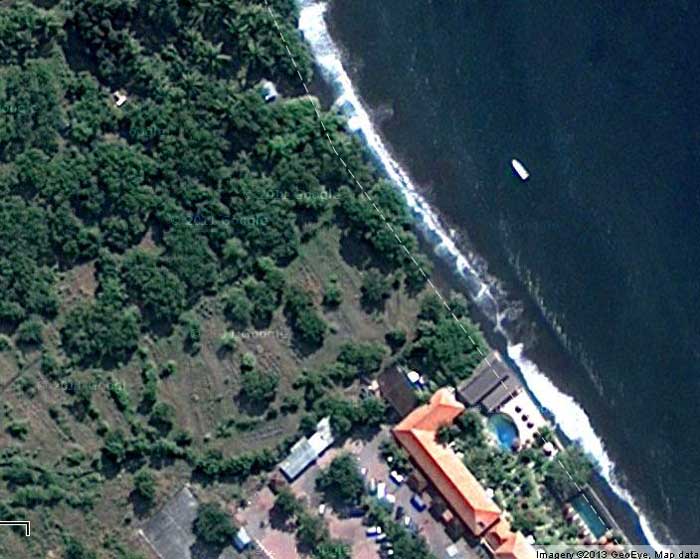 |
| A satellite photo from Google Earth that shows the location of the dive site - the site is near the boat and you enter from the shore straight opposite it |
As with virtually all dive sites that you do here, you gear up at the dive shop and then walk to the actual site. Meanwhile, your dive gear is transported by porters (on their head or on a scooter). From the Tulamben Wreck Divers shop you walk across the road and down the access road that leads to the car park for diving the wreck. A short walk down a track from the car park takes you to the beach where the wreck dive starts.
While the wreck is about 45Âș to the left, this dive straight out and down. The beach is composed of small and large rounded rocks. This makes it a little difficult to enter the water and great care needs to be taken to ensure that you do not twist an ankle. Once in the water you put on your fins and only swim out about five metres before descending.
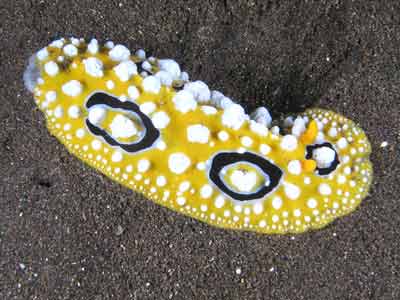 | 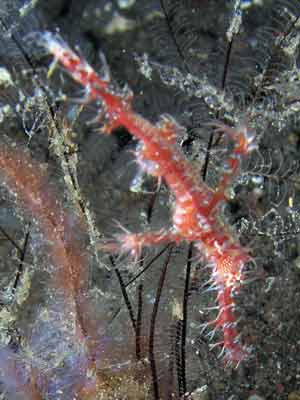 |
| Ocellate phyllidia | Ornate ghost pipefish |
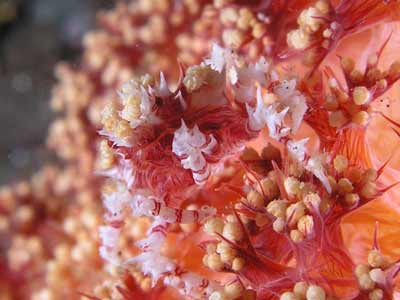 |  |
| Soft coral crab | A very strange looking crab |
The depth straight away is about four or so metres and within a few seconds you have left the rocks behind. The bottom here is black sand. There are a number of ridges that run at right angles to the beach and in between there are gullies. All of this is black sand. On the ridges there are very small outcrops of coral, perhaps growing on rocks from the shore. The gullies are generally free of coral, but this does not make them boring at all.
You swim out and normally follow one of the ridges to the deeper water. We generally went to about 24 to 28 metres before stopping. From here we gradually ascend, zig-zagging as we go. Sometimes you might head across the gully to the next ridge and then back again or sometimes just go up the ridge or the gully.
 |  |
| The amazing mimic octopus | Hermit crab |
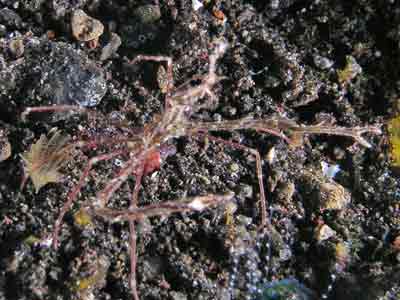 |  |
| Is this an orangatan crab without its"fur"? | Orangatan crab |
While most of the dive is spent looking at the small coral outcrops, even on the sand there is much to see. On this dive we saw mimic octopus, a very rare creature indeed. While you do not need a guide on these dives, the advantage of having one, at least for the first dive, is that they know where the special creatures live on the reef.
We also saw a couple of ornate ghost pipefish, many different species of crab, shrimp and nudibranch. There are also garden eels up in the shallower parts (6 to 8 metres), but you will only see them at less busy times of the day.
Eventually after an hour or so you end up low on air and back near the shore, so a swim into the shallows and eventually you can stand up and struggle out over the rocks. It is a bit easier I think exiting as you are walking slightly uphill.
 |  |
| A goby | A pair of Tryon's risbecia |
This was brilliant dive site, as good as any dive you would ever want to do. The visibility was probably 20 to 25 metres and the water temperature was about 27ÂșC.
Click here to return to the list of sites we did at Tulamben. | 
 v6.00.307 © 2003-2005
v6.00.307 © 2003-2005